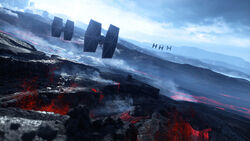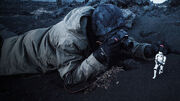| | |
Warning: This infobox has missing parameters: otherlife and unrecognized parameters: imageBG
- "What of the reports of the Rebel fleet massing near Sullust?"
"It is of no concern." - ―Darth Vader and Emperor Palpatine
Sullust was a planet located in the Sullust system of the Outer Rim Territories that was home to the Sullustan species.
Description
Sullust was a barren, obsidian world of lava streams and turquoise lakes. Native fauna such as ash angels foraged during the day and returned to nest at night, while rockrenders and sullustan worms prowled the planets underground.[4] Native Sullustans lived in vast, underground cities and commuted to work by lifts and shuttles which carried them to the factories on the planets surface, alternating between day and night shifts.[8] The SoroSuub Corporation employed roughly half the population of Sullust.[11]
History
Imperial reorganization
The Imperial controlled Sorosuub Centroplex was heavily fortified with many defenses including orbital turbolasers.
In its earliest days, Sullust was a proud and influential member in the Galactic Republic, and was host to the Sullust Sector Spacefarers Academy that young Wilhuff Tarkin himself attended. In the years following the Invasion of Naboo, the rogue Jedi Count Dooku spread political turmoil on worlds such as Kashyyyk, Onderon and Sullust.[2] During the Clone Wars, it hosted a battle between the Galactic Republic and the Confederacy of Independent Systems.[3] The planet eventually came under the jurisdiction of the nascent Galactic Empire following the proclamation of the New Order, and was reduced to vassal status and source of fuel for the Imperial Military, becoming an essential mining and manufacturing center for the Empire.[8]
For years, Sullust remained relatively peaceful as workers accepted the stability offered under the Empire's reign, however the Cobalt Laborers' Reformation Front steadily began to increase in numbers, sending letters to the Imperial governor demanding better working conditions and increased local autonomy. In response, the Empire detained roughly eighty percent of those in the organization and those it deemed most radical.[8]
Imperial occupation
Shortly after the Disaster, an enclave of Alderaanian refugees took up shelter on Sullust, hoping to escape Imperial reprisals against the remaining population of Alderaan.[4]

TIE fighters in flight on Sullust
In the three and a half years after the Battle of Yavin and the rise of the Rebel Alliance, the Imperial Security Bureau began to suspect the group of harboring rebel sympathizers and materiel for a possible resistance movement. In reality, the group had no connection to the local Sullustan resistance on the planet, however that did not stop the Empire from locking down the city and enacting door-to-door searches and mass arrests following a pipe bomb being blown in a nearby manufacturing facility in the city of Pinyumb.[8]
Weeks later and shortly following the Battle of Hoth, the Rebel Alliance initiated Operation Ringbreaker, which sought to force Imperial redeployments from the shipbuilding world of Kuat by assaulting worlds such as Obumubo, Naator, Xagobah and the asteroid mines of the Kuliquo belt, thus allowing for the Alliance to assault its ultimate goal. When the Alliance Sixty-First Mobile Infantry jumped out of hyperspace a mere half million kilometers from the planet in an effort to rapidly deploy drop ships to assault the Inyusu Tor mineral processing facility, the attack ultimately went awry the following day when the Imperial Vixus Squadron ambushed their troop transports, stranding the company on the planet. The next three days would result in the bloody Siege of Inyusu Tor, initially being in the Empire's favor as the Imperial-class Star Destroyer Herald arrived in the system and the Imperial Army utilized overwhelming force to surround the rebels on the mountainside facility. However, after receiving aid from the local resistance as well as finally convincing the Cobalt Front to rise up in Pinyumb, the Imperials were overwhelmed, while subsequent uprisings across the planet ultimately liberated it from Imperial rule.[8]
In the following days, an interim government would be installed in Pinyumb, while heavy losses sustained by the Sixty-First would ultimately cancel Operation Ringbreaker, allowing the company to act as a temporary police force for the Sullustan people. Subsequent pirate broadcasts and intercepted Imperial signals indicated further insurrections across the planet, delaying the inevitable Imperial counterattack.[8]
Regrouping over Sullust
- "Sullust is an opportunity for us—we have contacts with its underground. Our armada will gather there. The commando team will go first, to bring down the battle station's shields. Then the fleet will travel down the Sanctuary Pipeline to Endor."
- ―Admiral Gial Ackbar, explaining the plan to destroy the Death Star II on Zastiga
Months later, the Alliance to Restore the Republic used the planet as the staging area for its fleet prior to the Battle of Endor.[12]
The New Republic
Twenty-four years after the battle of Endor, Sullust was represented in the New Republic Senate by the Populist senator Anib Ney.[13]
Behind the scenes

Star Wars Battlefront team member on Iceland, which served as a template for Sullust
Sullust first appeared in the N64 game Star Wars: Rogue Squadron, but its first canonical appearance was in Star Wars: The Clone Wars. The planet's subsurface was depicted in the Princess Leia comic. Its surface as depicted in Star Wars Battlefront was based on Iceland.[14] Doug Chiang said DICE proposed the look, and Lucasfilm agreed:
- "[We wanted] to come up with something that could really complement what the other planets are. We knew in Battlefront that we were going to have a snow planet, a desert planet, and a forest planet. [sic] What else could we put in there to make it texturally more interesting? Iceland turned out to be a great candidate — the Icelandic lava flows. And that feel was very unique."
- ―
 World Building: Doug Chiang on Creating Sullust for Star Wars Battlefront – Exclusive Interview on StarWars.com (backup link)
World Building: Doug Chiang on Creating Sullust for Star Wars Battlefront – Exclusive Interview on StarWars.com (backup link)
DICE’s Audio Director Ben Minto recorded various sounds in Iceland, including bubbling mud pools, shrimp and cod grunts; or huge steel guy-wires from the Longwave radio mast Hellissandur.[15]
Appearances
 Star Wars: The Clone Wars — "Nightsisters" (First appearance)
Star Wars: The Clone Wars — "Nightsisters" (First appearance) Star Wars: The Clone Wars — "Witches of the Mist" (Mentioned only)
Star Wars: The Clone Wars — "Witches of the Mist" (Mentioned only)- Adventures in Wild Space: The Escape (Indirect mention only)
- Tarkin (In flashback(s))
- Star Wars: Princess Leia, Part III
- Heir to the Jedi (Mentioned only)
- Star Wars: Commander
- Star Wars Battlefront
- Battlefront: Twilight Company
- Moving Target: A Princess Leia Adventure (Appears in hologram)
- Star Wars: Episode VI Return of the Jedi (First mentioned)
- Bloodline (Mentioned only)
Sources
 Nien Nunb in the Encyclopedia (content now obsolete; backup link)
Nien Nunb in the Encyclopedia (content now obsolete; backup link) Princess Leia #3 – Exclusive Preview! on StarWars.com (backup link)
Princess Leia #3 – Exclusive Preview! on StarWars.com (backup link)- Ultimate Star Wars
- Star Wars in 100 Scenes
 Mister Borkus in the Databank (backup link)
Mister Borkus in the Databank (backup link) Nien Nunb in the Databank (backup link)
Nien Nunb in the Databank (backup link) Rebel Alliance in the Databank (backup link)
Rebel Alliance in the Databank (backup link) Sullust in the Databank (backup link)
Sullust in the Databank (backup link) World Building: Doug Chiang on Creating Sullust for Star Wars Battlefront – Exclusive Interview on StarWars.com (backup link)
World Building: Doug Chiang on Creating Sullust for Star Wars Battlefront – Exclusive Interview on StarWars.com (backup link)
Notes and references
- ↑ Star Wars: Princess Leia, Part II
- ↑ 2.0 2.1 2.2 2.3 Tarkin
- ↑ 3.0 3.1
 Star Wars: The Clone Wars — "Nightsisters"
Star Wars: The Clone Wars — "Nightsisters"
- ↑ 4.0 4.1 4.2 4.3 4.4 4.5 4.6 4.7 Star Wars: Princess Leia, Part III
- ↑ Moving Target: A Princess Leia Adventure
- ↑
 Sullust in the Databank (backup link)
Sullust in the Databank (backup link)
- ↑ 7.0 7.1 7.2 7.3 7.4 Star Wars Battlefront
- ↑ 8.00 8.01 8.02 8.03 8.04 8.05 8.06 8.07 8.08 8.09 8.10 8.11 8.12 8.13 8.14 Battlefront: Twilight Company
- ↑ Adventures in Wild Space: The Escape
- ↑
 Nien Nunb in the Encyclopedia (content now obsolete; backup link)
Nien Nunb in the Encyclopedia (content now obsolete; backup link)
- ↑ 11.0 11.1 The Planets of Star Wars Battlefront, published by ea.com on starwars.ea.com (November 5, 2015) (backup link not verified!)
- ↑ 12.0 12.1 Star Wars: Episode VI Return of the Jedi
- ↑ 13.0 13.1 Bloodline
- ↑ Star Wars Battlefront: 7 Things You Need to Know About Fighter Squadron Mode, published by YouTube on OutsideXbox (August 7, 2015) (backup link not verified!)
- ↑ Creating the Sounds of Star Wars Battlefront | starwarsea.com
